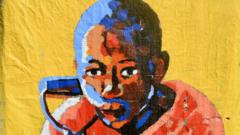Zambia's "black mountains," formed from decades of mining waste along the Copperbelt, provide a poignant backdrop for artist Stary Mwaba's latest exhibition at the Lusaka National Museum. Known for its environmental degradation, the area has long affected the lives of its residents. Mwaba reflects on his childhood in Kitwe, sharing tales of local kids who referred to these toxic heaps as "mu danger," or "in the danger," while they scavenged for wild fruits among the waste.
Today, many young men are drawn to these hazardous sites, searching for copper ore to sell to often unscrupulous buyers, with earnings being a crucial lifeline in a region where youth unemployment stands at around 45%. Mwaba’s exhibition highlights their plight, with a series of large portraits painted on newspaper, showcasing the individuals who endure the health hazards posed by these mountains. The artist remarks, "I take these grand narratives and create holes so you can't make sense of the stories anymore," signifying the often-overlooked experiences of ordinary people.
His art captures the community's spirit, illustrating scenes of mining, family life, and social engagements across the Wusakile neighbourhood. Through workshops, he has collected firsthand accounts of hardship, weaving them into his pieces. Portraits like "Jerabo" depict miners in precarious conditions, while "Shofolo" emphasizes the significance of simple tools, such as the shovel, in their lives.
Mwaba’s work reflects a deeply personal journey. Coming from a family of miners himself, he was inspired to address the mining issue after guiding his daughter through a science project about plant absorption in 2011. This experience sparked an exploration into the socio-economic impacts of mining—eventually culminating in his acclaimed piece featuring Chinese cabbages, which critiqued the influence of foreign mining interests in Zambia.
Returning to his roots over the years, Mwaba has witnessed shifts in the landscape, both physical and societal, recognizing the deeper implications of the mining crisis as it reshapes communities and the futures of many young people. His art aims not only to provoke thought but also to inspire change, urging the community to reflect on the ongoing exploitation and the personal stories that lie behind the statistics.
Amid rising frustrations among miners, one poignant artwork titled "Boss for a Day" captures the feelings of disempowerment faced by young workers. It serves as a visual representation of their aspirations against the backdrop of a toxic, entrenched mining culture. As Mwaba continues his mission, he hopes that sharing these narratives through his art can lead to a greater awareness and transformation for future generations navigating the challenges of life in Zambia’s Copperbelt.


















